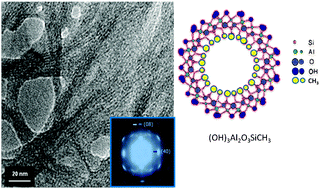Synthesis and characterization of hybrid organic/inorganic nanotubes of the imogolite type and their behaviour towards methane adsorption
Abstract
Imogolite-like

* Corresponding authors
a
Department of Materials Science and Chemical Engineering, Politecnico di Torino, and INSTM Unit – Torino Politecnico, Corso Duca degli Abruzzi 24, I-10129 Turin, Italy
E-mail:
barbara.bonelli@polito.it
Tel: +39-011-5644719
b School of Chemistry, University of St Andrews, Purdie Building, North Haugh, St Andrews, Fife, United Kingdom
c eni S.p.A, Refining & Marketing Division, Downstream Process Technology Department, via F. Maritano 26, I-20097 San Donato M.se, Italy
Imogolite-like

 Please wait while we load your content...
Something went wrong. Try again?
Please wait while we load your content...
Something went wrong. Try again?
I. Bottero, B. Bonelli, S. E. Ashbrook, P. A. Wright, W. Zhou, M. Tagliabue, M. Armandi and E. Garrone, Phys. Chem. Chem. Phys., 2011, 13, 744 DOI: 10.1039/C0CP00438C
To request permission to reproduce material from this article, please go to the Copyright Clearance Center request page.
If you are an author contributing to an RSC publication, you do not need to request permission provided correct acknowledgement is given.
If you are the author of this article, you do not need to request permission to reproduce figures and diagrams provided correct acknowledgement is given. If you want to reproduce the whole article in a third-party publication (excluding your thesis/dissertation for which permission is not required) please go to the Copyright Clearance Center request page.
Read more about how to correctly acknowledge RSC content.
 Fetching data from CrossRef.
Fetching data from CrossRef.
This may take some time to load.
Loading related content
